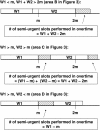Planning and scheduling of semi-urgent surgeries
- PMID: 20715308
- PMCID: PMC2886895
- DOI: 10.1007/s10729-010-9127-6
Planning and scheduling of semi-urgent surgeries
Abstract
This paper investigates the trade-off between cancellations of elective surgeries due to semi-urgent surgeries, and unused operating room (OR) time due to excessive reservation of OR time for semi-urgent surgeries. Semi-urgent surgeries, to be performed soon but not necessarily today, pose an uncertain demand on available hospital resources, and interfere with the planning of elective patients. For a highly utilized OR, reservation of OR time for semi-urgent surgeries avoids excessive cancellations of elective surgeries, but may also result in unused OR time, since arrivals of semi-urgent patients are unpredictable. First, using a queuing theory framework, we evaluate the OR capacity needed to accommodate every incoming semi-urgent surgery. Second, we introduce another queuing model that enables a trade-off between the cancelation rate of elective surgeries and unused OR time. Third, based on Markov decision theory, we develop a decision support tool that assists the scheduling process of elective and semi-urgent surgeries. We demonstrate our results with actual data obtained from a department of neurosurgery.
Figures







Similar articles
-
Allocating operating room capacity to non-elective neurosurgical patients improves access and safety for elective patients at Aarhus University Hospital.Br J Neurosurg. 2025 Jun;39(3):296-302. doi: 10.1080/02688697.2023.2228916. Epub 2023 Jul 5. Br J Neurosurg. 2025. PMID: 37403673
-
Operating Rooms Scheduling for Elective Surgeries in a Hospital Affected by War-Related Incidents.J Med Syst. 2019 Apr 10;43(5):139. doi: 10.1007/s10916-019-1263-z. J Med Syst. 2019. PMID: 30972511
-
Prioritising patients for semi-urgent surgery: A scoping review.J Clin Nurs. 2024 Jul;33(7):2509-2524. doi: 10.1111/jocn.17056. Epub 2024 Feb 9. J Clin Nurs. 2024. PMID: 38334175
-
A random forest and simulation approach for scheduling operation rooms: Elective surgery cancelation in a Chinese hospital urology department.Int J Health Plann Manage. 2018 Oct;33(4):941-966. doi: 10.1002/hpm.2552. Epub 2018 Jun 28. Int J Health Plann Manage. 2018. PMID: 29956373
-
Ethical considerations and patient safety concerns for cancelling non-urgent surgeries during the COVID-19 pandemic: a review.Patient Saf Surg. 2021 Apr 29;15(1):19. doi: 10.1186/s13037-021-00293-7. Patient Saf Surg. 2021. PMID: 33926498 Free PMC article. Review.
Cited by
-
Machine learning based integrated scheduling and rescheduling for elective and emergency patients in the operating theatre.Ann Oper Res. 2023 Jan 19:1-24. doi: 10.1007/s10479-023-05168-x. Online ahead of print. Ann Oper Res. 2023. PMID: 36694896 Free PMC article.
-
How to juggle priorities? An interactive tool to provide quantitative support for strategic patient-mix decisions: an ophthalmology case.Health Care Manag Sci. 2011 Dec;14(4):348-60. doi: 10.1007/s10729-011-9168-5. Epub 2011 Jun 4. Health Care Manag Sci. 2011. PMID: 21643698 Free PMC article.
-
Managing admission and discharge processes in intensive care units.Health Care Manag Sci. 2021 Dec;24(4):666-685. doi: 10.1007/s10729-021-09560-6. Epub 2021 Jun 10. Health Care Manag Sci. 2021. PMID: 34110549 Free PMC article.
-
A MIP Model for Rolling Horizon Surgery Scheduling.J Med Syst. 2016 May;40(5):127. doi: 10.1007/s10916-016-0490-9. Epub 2016 Apr 12. J Med Syst. 2016. PMID: 27071394
-
Appointment Scheduling Problem in Complexity Systems of the Healthcare Services: A Comprehensive Review.J Healthc Eng. 2022 Mar 3;2022:5819813. doi: 10.1155/2022/5819813. eCollection 2022. J Healthc Eng. 2022. PMID: 35281532 Free PMC article. Review.
References
-
- Schofield WN, Rubin GL, Piza M, Yin Lai Y, Sindhusake D, Fearnside MR, Klineberg PL. Cancellation of operations on the day of intended surgery at a major Australian referral hospital. MJA. 2005;182(12):612–615. - PubMed
-
- Gerchak Y, Gupta D, Henig M. Reservation planning for elective surgery under uncertain demand for emergency surgery. Manag Sci. 1996;42(3):321–334. doi: 10.1287/mnsc.42.3.321. - DOI
-
- Cardoen B, Demeulenmeester E, Beliën J (2008) Operating room planning and scheduling: a literature review. Internal report, K.U. Leuven, Belgium. Available at https://lirias.kuleuven.be/handle/123456789/165923
MeSH terms
LinkOut - more resources
Full Text Sources

